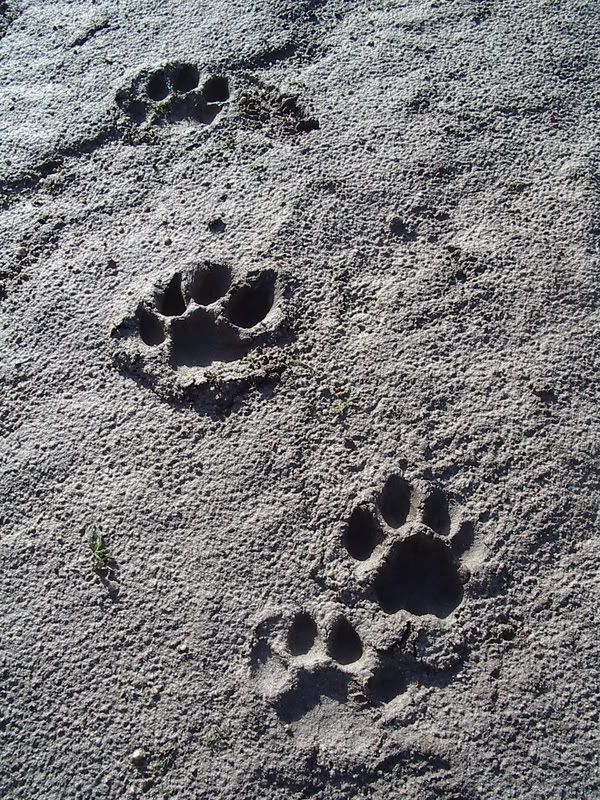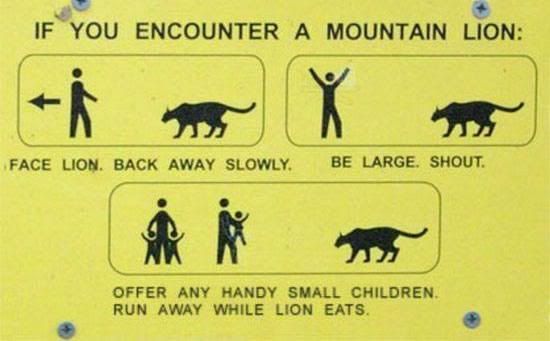posted September 01, 2008 01:17 PM


The Mountain Lion2 weeks ago I attended a class given by the County of Marin, and the Calif. Dept. of Fish and Game, titled "Living with Mountain Lions". It was really great and very informative. So the following information is from notes I took during the class and from literature given.
The Mountain Lion is also known as the cougar, panther, or puma. The Florida Panther is a Mountain Lion.
Physical Appearace: tawny colored with black tipped ears and tails. The head is smaller compared to the rest of the body. Females weigh about 70 lbs. and males about 150 lbs. in average. They have a very long tail = 2/3 the length of their entire body. The long tail is used for balance in jumping. M.L. kittens are covered with black/brown spots and have dark rings around their tails. These markings fade as they mature. Kittens stay with their mothers for up to 2 years. Their mothers teach them to eat from a carcass after about 2 1/2 months of age. Males are a large threat to kittens because a male's goal is to pass on his genes; he will want to kill the kittens so he can then bring the mother back into estrus, mate with her, and thus pass on his own genes by leaving his own offspring. A male has no idea whether or not the kittens were originally his in the first place. Some other species, may perhaps recognize their own offspring, such as by scent or those species where both the males and females raise offspring together, but not Mountain Lions.
Habitat: diverse - wherever you find deer, you can expect to find Mountain Lions. from British Colombia, Canada, all the way to South America, across the United States from Calif. to Florida. Males are mutually intolerant of other males. M/F are okay together, and there can be an overlap of Females. The home range of a M.L. is up to 400 square miles. M.L.'s use territorial scraping to mark their territories.
It is very rare that you will ever see a Mountain Lion in the wild, on your own. M.L.'s are generally very calm, quiet, and elusive. They usually hunt at night. They can be unpredictable and very quick. If you do encounter a Mountain Lion in the wild, do not behave as a deer would. A deer may just stand there and do the "headlights stare", or the deer may run. Do not crouch down or bend over. Do not appear as "prey". You want to show the M.L. that you are loud and noisy, and LARGE. Take your jacket or sweater and hold your arms up way over your head, make noise. Don't ever turn your back on a M.L, as they kill their prey by snapping/biting the back of the neck.
As Predators: M.L.'s usually kill 1 deer every 2 weeks. They break the rib cage and eat the highest food quality organs first = the heart and liver. They are very clean killers, snapping the back of the neck of their prey. They cover the carcass of their prey very neatly and very thoroughly to hide it from other scavengers. They use leaves, branchs, and dirt to cover, and contain the carcass very well. They return for up to a couple weeks to feed on their cached carcass. (yes, that word is "cache" not "catched")
Dogs and coyotes rip their prey's carcass apart, and leave very messy evidence of their kill. This is how you can tell who killed the deer you have just stumbled across.
Another bit of evidence that a Mountain Lion has been around, is that they drag their prey. If you are out in the wilderness and see evidence of a large drag mark in the dirt, you can be sure that a Mountain Lion is in your vicinity.
Tracks: An adult M.L.'s tracks are about 3 1/2 inches in length and 3 inches in width. They have 4 teardrop shaped toe pads, the leading toe of each foot slightly ahead of the others. the main heel pad is rigid across the top and 3 lobes on the bottom, like an upside down M. if you divide the track mark into two crosses, there will be asymmetry. ( Dog tracks are symmetrical)
For more info. visit www.dfg.ca.gov


The bottom rule is a joke, please don't offer any small children! Protect them!


 Lindaland
Lindaland

 Heathcliffe's Corner
Heathcliffe's Corner

 September Animal of the Month ~ Mountain Lion
September Animal of the Month ~ Mountain Lion

